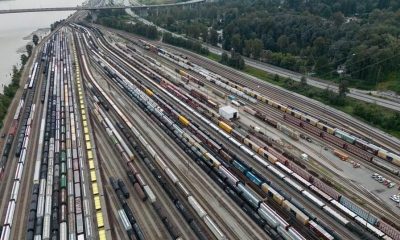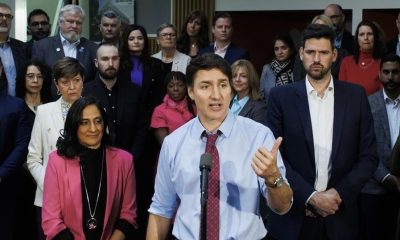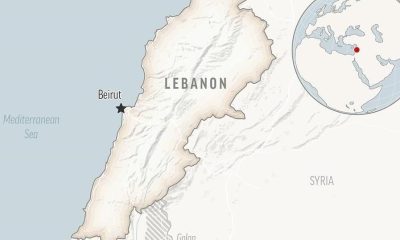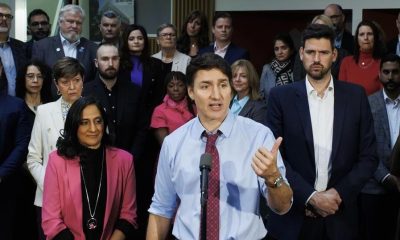Economy
Quebec hikes spending to 'stimulate' economy amid global uncertainty – BNNBloomberg.ca

Quebec Finance Minister Eric Girard is betting that big spending increases in the budget he tabled Tuesday will stimulate the provincial economy enough to ward off any economic damage resulting from the novel coronavirus.
The Coalition Avenir Quebec government’s second budget projects a $2.7-billion surplus, increases program spending by 5.1 per cent over the previous fiscal year and includes billions more in borrowed funds to finance big-ticket infrastructure projects such as new public transit.
Girard told reporters government “has a role to play to stimulate the economy” amid disruptions in global supply chains and weakening private demand for products and services due to the global spread of COVID-19.
“It’s possible the virus has an impact on consumer and business confidence,” he said. But, he added, the spending increases are “coming at the right time.”
Girard acknowledged that the effects of the virus on the global economy are evolving quickly. As of Saturday, he said, his department estimated the virus could cause global economic growth to fall by half a percentage point this year.
“When we look at the sensitivity of the Quebec economy to the world economy, it could correspond to about half, so 0.25 per cent,” he said. “All this is manageable.”
Moreover, the 2020-21 budget provides a surplus of $2.7 billion that could be used to cushion any unforeseen blows from the virus, Girard said.
Liberal finance critic Carlos Leitao called the lack of specific funding to address the effects of the coronavirus “hazardous.” He said it’s been clear since the beginning of the year that the global, Canadian and Quebec economies are slowing.
On Monday, he had called for a contingency fund of roughly $1 billion to deal with economic shocks caused by the virus. “There is zero,” Leitao said. “Absolutely nothing, no provision for eventualities. I think it’s extremely hazardous to make a budget like that in this economic climate.”
Girard, however, said, “We are ready.”
Health and education program spending will grow significantly in 2020-21, by 5.3 per cent and 4.5 per cent respectively. Girard said if the Health Department needs more money for coronavirus-related spending, “we have the capacity to deliver.”
The budget also includes an increase of $15.1 billion in infrastructure spending over the next 10 years, bringing the total to $130.5 billion.
That money, which will be borrowed primarily through the sale of government bonds, is earmarked to fund new schools, senior centres and major public transit projects. The budget projects the province borrowing about $14 billion for capital spending in 2020-21 and about $27 billion a year after that, until 2024-25.
Girard said another factor giving him confidence Quebec can weather the expected storm is the fact the province’s economic fundamentals are so strong.
“It’s important to understand where we are starting from,” he said before tabling his budget in the legislature. “The foundations of the Quebec economy are extremely solid and the performance of the Quebec economy is really in a good position.”
GDP grew by 2.8 per cent in 2019, up a full percentage point from what Girard had forecast this time last year. He estimates GDP growth in 2020 will be 2.0 per cent.
Quebec projects its revenues will grow 2.8 per cent in fiscal 2020-21, to roughly $121.3 billion, and its expenditures will be $118.6 billion during the same period, leaving a $2.7 billion surplus that will be deposited into a special fund created to pay down debt.
And while the province says its gross GDP-to-debt ratio has declined to 43 per cent, the government is still significantly in debt, by close to $197.7 billion. The province’s projected debt servicing costs for 2020-21 are $8.3 billion.
Despite higher revenues and stronger GDP, the government budgeted only modest tax cuts in the form of school tax reductions. The measure amounts to roughly $180 million in 2020-21.
With a stylized tree on the cover of the budget’s printed version, the government framed it as focused on the environment, and it budgeted $6.2 billion over six years to reduce greenhouse gas emissions. Most of that money is projected to come from revenues collected by businesses from the carbon market in which it participates with California. The new government money equals $2.1 billion over the same period.
Just like their government, Quebecers are making more money and spending more, the budget shows. Girard projects the province will collect 5.8 per cent more in income taxes this fiscal year and 3.8 per cent more in consumption taxes.
The budget says 77,700 jobs were created in 2019, and the unemployment rate was 5.1 per cent.
Economy
The AI Supply Shock Is Coming for Nations Everywhere – Bloomberg
[unable to retrieve full-text content]
The AI Supply Shock Is Coming for Nations Everywhere Bloomberg

Source link
Economy
Norway’s Economy Ekes Out a Gain for Third Straight Quarter
(Bloomberg) — The Norwegian economy recorded a third consecutive quarter of expansion, as a recovery in purchasing power bolstered car purchases and a weak krone underpinned exports.
Mainland gross domestic product, which excludes offshore energy industry and shipping, grew by 0.1% in the second quarter from the previous three months, according to a release from Statistics Norway published Thursday. First-quarter growth was revised lower to 0.1%.
Thursday’s reading was just below the 0.2% growth estimated by both the central bank and economists in a Bloomberg survey.
The outcome shows the energy-rich Nordic nation is dented more than previously assumed by the fallout from interest rates at a 15-year high, even as the slowing inflation and wage growth above 5% fuel consumption.
The weaker-than-forecast figures, together with revision of earlier data, may still increase the odds of Norges Bank reducing borrowing costs before next year. The Norwegian policymakers have kept delaying monetary easing as one of the most aggressively hawkish in the rich world, forecasting no change “for some time ahead” at their meeting last week.
“Negative revisions clearly leave a picture of a weaker mainland economy than Norges Bank projected back in June,” said Kristoffer Kjaer Lomholt, head of FX and corporate research at Danske Bank A/S. “All in all, a report that should keep the door open for a December cut.”
Household consumption grew by 1.6% on quarter due to a “strong upswing” in car purchases, the statistics office said, while noting the figures for the sector can fluctuate “widely.” Trade and power supply also helped boost mainland growth, it said.
The krone is hovering near four-year lows, helping demand for Norwegian exports, as well as its tourism sector. It was little changed following the report, trading 0.1% lower at 11.7233 versus the euro at 8:50 a.m. in Oslo.
Total exports grew 5.6% on quarter, the fastest increase in almost two years, as oil and gas shipments were less affected by maintenance works that are usual for the season.
The country’s largest lender, DNB Bank ASA, on Wednesday kept its forecast for full-year growth of 0.8% in 2024 and projected next year’s growth at 1.6%, largely due to higher purchasing power of consumers. That compares with Norges Bank’s estimates of expansion of 0.8% and 1.3%, respectively, published in June.
Analysts at DNB and Svenska Handelsbanken AB said the deviation from the central bank’s estimates was too small to clearly affect policymakers’ rate outlook.
–With assistance from Joel Rinneby.
(Updates with analyst comment, market reaction from fourth paragraph.)
©2024 Bloomberg L.P.
Economy
Gaza war extends toll on Israel’s economy
Last week, Fitch Ratings downgraded Israel’s credit score from A+ to A. Fitch cited the continued war in Gaza and heightened geopolitical risks as key drivers. The agency also kept Israel’s outlook as “negative”, meaning a further downgrade is possible.
After Hamas’s deadly attack on October 7, Israel’s stock market and currency nosedived. Both have since bounced back. But concerns about the country’s economy persist. Earlier this year, Moody’s and S&P also cut their credit ratings for Israel.
So far, Israel’s war on Gaza has killed more than 40,000 Palestinians and decimated the economy in the besieged Palestinian enclave.
There are signs of a blowback in Israel, too, where consumption, trade and investment have all been curtailed.
Separately, Fitch warned that heightened tensions between Israel and Iran could incur “significant additional military spending” for Israel.
The Bank of Israel has estimated that war-related costs for 2023-2025 could amount to $55.6bn. These funds will likely be secured through a combination of higher borrowing and budget cuts.
The upshot is that combat operations are putting a strain on the economy. On Sunday, Israel’s Central Bureau of Statistics estimated that output grew by 2.5 percent (at an annual rate) in the first half of 2024, down from 4.5 percent in the same period last year.
Slowing growth
Before the outbreak of the war, Israel’s economy was forecast to grow by 3.5 percent last year. In the end, output expanded by just 2 percent. An even sharper drop was avoided thanks to the country’s all-important tech sector, which has been largely unaffected by fighting.
Other parts of the economy have taken a significant hit. In the final quarter of last year and in the weeks after the war began, Israel’s gross domestic product (GDP) shrank by 20.7 percent (in annual terms). The slump was driven by a 27 percent drop in private consumption, a drop in exports and a slash in investment by businesses. Household expenditure snapped back at the start of the year, but has since cooled.
Israel also imposed strict controls on the movement of Palestinian workers, forgoing up to 160,000 workers. To tackle those shortages, Israel has been running recruitment drives in India and Sri Lanka with mixed results. But labour markets remain undersupplied, particularly in the construction and agriculture sectors.
According to the business survey company CofaceBDI, roughly 60,000 Israeli companies will close this year due to manpower shortages, logistics disruptions and subdued business sentiment. Investment plans have, in turn, been delayed.
At the same time, tourist arrivals continue to fall short of pre-October levels.
Meanwhile, the war has triggered a steep rise in government spending. According to Elliot Garside, a Middle East analyst at Oxford Economics, there was a 93 percent increase in military expenditure in the last three months of 2023, compared to the same period in 2022.
“In 2024, monthly data suggests military expenditure will be around double the previous year,” Garside said. Much of that increase will be used on reservist wages, artillery, and interceptors for Israel’s Iron Dome defence system.
Garside told Al Jazeera these expenditures “have mostly been financed by issuance of domestic debt”.
Israel has also received some $14.5bn supplemental funding from the United States this year, on top of the $3bn in annual aid that the US provides to the country.
Garside noted, “We are yet to see any major cutbacks to other parts of the budget [like healthcare and education], although it is likely that cuts will be made in the aftermath of the conflict.”
Absent a full-scale regional war, Oxford Economics anticipates that Israel’s economy will slow to 1.5 percent growth this year. Subdued growth and elevated deficits will put further pressure on Israel’s debt profile, which will likely raise borrowing costs and soften investor confidence.
Bruised public finances
Fitch expects Israel to permanently increase military spending by 1.5 percent of GDP compared to prewar levels, with unavoidable consequences for the public deficit. Last week’s rating report noted that “debt [will] remain above 70 percent of GDP in the medium-term”.
What’s more, the rating agency warned that “the conflict in Gaza could last well into 2025 and there are risks of it broadening to other fronts”.
Regional conflict
On Monday, US Secretary of State Antony Blinken said that Netanyahu had accepted a “bridging proposal” designed to reach a ceasefire between Israel and Hamas and diffuse growing tensions with Iran.
The following day, eight Palestinians were killed in an Israeli attack on a crowded market in Deir el-Balah, in central Gaza.
Hamas has yet to agree to the bridging proposal, calling it an attempt by the US to buy time “for Israel to continue its genocide”. Instead, the Palestinian group has urged a return to a previous proposal announced by US President Joe Biden, which has more guarantees that a ceasefire would bring about a permanent end to the war.
Netanyahu has insisted that the war will continue until Hamas is totally destroyed, even if a deal is agreed. Israeli officials, including Defence Minister Yoav Gallant, have rubbished the idea of a total victory against Hamas.
A decades-old shadow war between Israel and Iran surfaced in April, when Tehran launched hundreds of drones and missiles at Israel in response to the killing of two commanders from Iran’s Islamic Revolutionary Guard Corps (IRGC) in Damascus.
Along its Lebanese border, Israel has traded near-daily attacks with Hezbollah since last October. The armed group began firing on Israel as a show of solidarity with Hamas. Both organisations have close ties with Iran.
More recently, the assassinations of Hamas leader Ismail Haniyeh in Tehran and Hezbollah military commander Fuad Shukr in Beirut have sparked fears that the conflict in Gaza could metastasise into a regional conflict.
“The human toll [of a wider war] could be significant. There would also be huge economic costs,” says Omer Moav, an Israeli economics professor at the University of Warwick.
“For Israel, a long war would come with high costs and greater deficits,” he said.
In addition to undermining Israel’s debt profile, Moav said that prolonged fighting would incur “other costs”, like labour shortages and infrastructure damage, as well as the possibility of international sanctions against Israel.
“Israel is currently ignoring the fact that economics may lead to greater [societal] damage than war itself,” said Moav. “The government is not behaving responsibly. Does it want to avoid the costs of war, or does continued conflict serve political interests?”
-

 News19 hours ago
News19 hours agoCompanies take stock of rail shutdown’s hit to economy — and bottom lines
-

 News12 hours ago
News12 hours agoFeds identify 56 government properties for conversion to affordable housing
-

 News19 hours ago
News19 hours agoIsrael and Hezbollah trade heavy fire before pulling back, jolting a region braced for war
-

 News12 hours ago
News12 hours agoMontreal commuter lines halted by rail shutdown to run again starting Monday: Exo
-

 News19 hours ago
News19 hours agoFeds to take steps on housing promises ahead of cabinet retreat in Halifax
-

 News13 hours ago
News13 hours agoDid Taylor Swift create a new era for food bank donations?
-

 News14 hours ago
News14 hours agoBabe Ruth’s ‘called shot’ jersey sells at auction for over $24 million
-

 News23 hours ago
News23 hours agoThis bird species was extinct in Europe. Now it’s back, and humans must help it migrate for winter






















